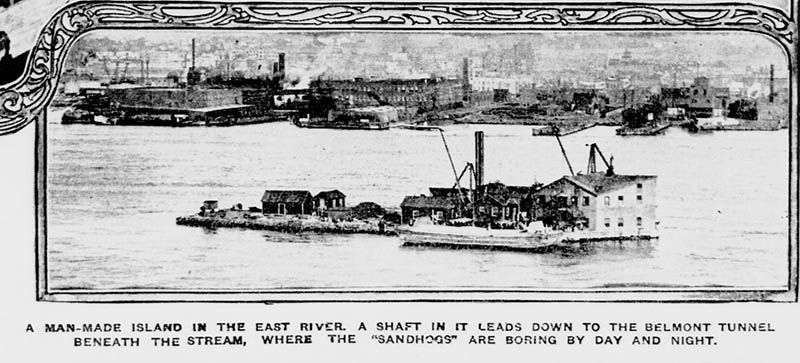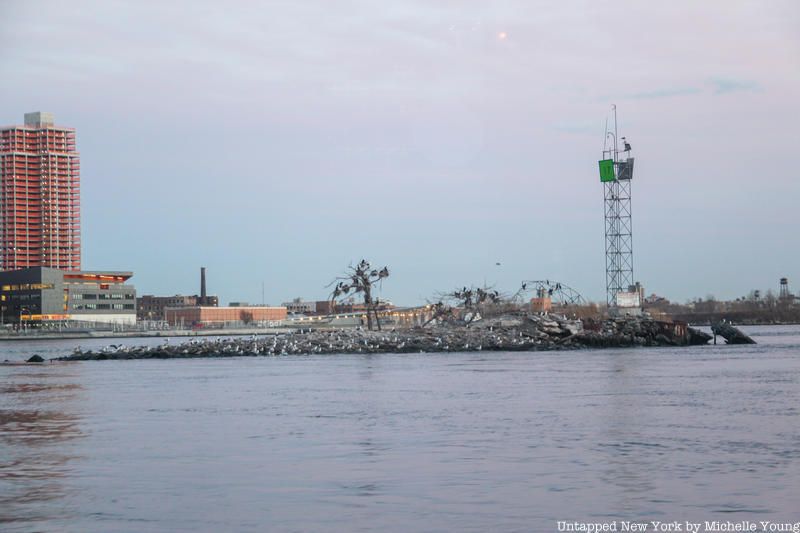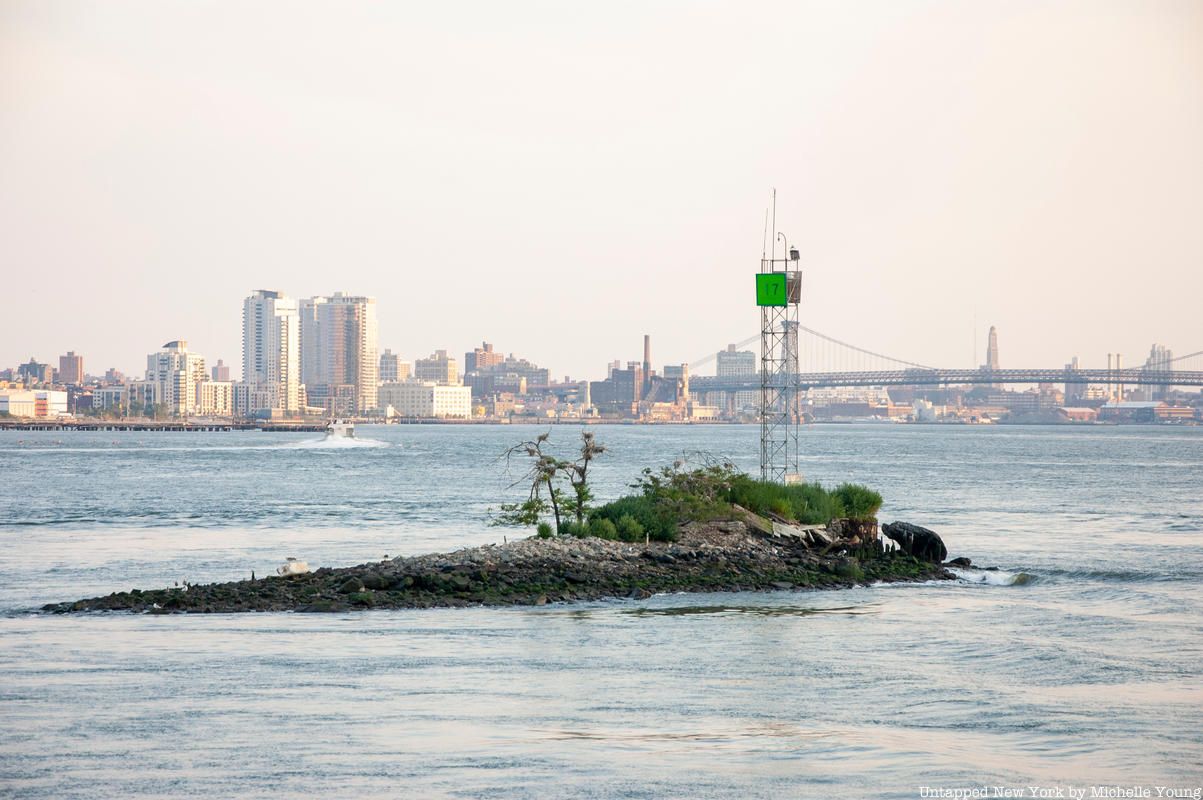Last-Minute NYC Holiday Gift Guide 🎁
We’ve created a holiday gift guide with presents for the intrepid New Yorker that should arrive just in time—


Situated halfway between the United Nations complex and Long Island City is a tiny 1/2 acre island that appeared in the East River in the 1890s. U Thant Island, as it is known, is nicknamed after former United Nations Secretary General from Burma — a story we will get into shortly. The island was created from materials excavated by piano manufacturer William Steinway in the attempt to build underwater trolley tunnels in the East River between Manhattan and his company town in Astoria, Steinway Village. Workers dug a shaft down through an outcropping of granite rock known then as Man-o’-War Reef and the excavated rubble formed the man-made island, officially known as Belmont Island.

October 14, 1906 New York-Tribune. Image from Library of Congress, Serial and Government Publications Division.
Steinway died in 1896 before the completion of the tunnels, which were finished a decade later under the auspices of the first subway line, the Interborough Rapid Transit (IRT). A historic photograph in the New-York Tribune from 1906 shows the newly created island packed with buildings and the mining shaft. Nobody lived here — it was intended for the equipment and activity connected to the mine and as an access point to the tunnels below. The caption reads: “A man-made island in the East River. A shaft it in leads down to the Belmont Tunnel beneath the stream, where the ‘sandhogs’ are boring day and night.” Those buildings remained on the island until around 1918.
The construction of the Steinway Tunnel was by no means a safe endeavor. Four workers died in an accident in the shaft in 1906. Much like the engineering feat that was the creation of the first East River tunnel just nearby in 1893, these large infrastructure projects were the products of ambitious, sometimes grandiose, visions of what the city could be. Today the tunnels are still used by the 7 line train, a testimony to the foresight of Steinway, Belmont and the early industrialists.

Belmont Island was named for August Belmont Jr. who was one of the main financiers of the IRT and its President. He was so important, he actually had his own private subway car that still exists today. How did it became known as U-Thant Island? In the 1970s, a group of employees from the United Nations who were followers of the guru Sri Chinmoy and called themselves the Peace Meditation at the United Nations unofficially named it for Chinmoy’s friend U Thant, the UN Secretary General from Burma. Chinmoy, who was born in British India (now Bangledesh) came to the United States in 1964 and lived in Jamaica, Queens. He was giving meditations twice a week at the United Nations, on invitation from U Thant.
The use of U Thant Island was a formal takeover, as the group leased the island from the State of New York and dedicated the island on September 16, 1977 to U Thant, who had died three years before. After New York Governor Hugh Carey stated his support of the initiative, the group “planted trees and flowers, and inaugurated its official lease of the island from the state,” according to Charlie Hailey in the book Spoil Island: Remaking the Makeshift Archipleago. There was even an award ceremony for the U Thant Peace Award that took place there.

The United Nations from the East River
The group was allowed on U Thant Island once or twice a year to maintain the greenery they planted, but increased security pretty much ended visits by the mid 1990s. They left behind a 30-foot tall steel “Oneness Arch” which has a capsule buried below containing personal items and writings from U Thant. The arch is still there, next to U.S. Coast Guard beacon that also has a sign with the nickname of the Island, the UN logo, the words “U Thant Island: Compassion—Home. Dedicated to World PEace through Prayer and Meditation” and a quote by U Thant: “Every man or woman should not only ask himself or herself what he or she is going to do in the world, but also ask ‘Will there be a world in which I can live.'” We have not been able to confirm if the personal items are still there.
It wasn’t the first or last takeover of U Thant Island. In 1972, activists occupied the island for 2 1/2 hours and declared it the “Soviet Jewry Freedom Island” in protest of a speech at the United Nations by Leonid Brezhnev, the long time Chairman of the Presidium of the Supreme Soviet and his announcement of the diploma tax that was enacted on graduates from the USSR who wished to emigrate.The occupation was led by Percy Sutton and Robert Abrams, the Manhattan and Bronx Borough Presidents respectively. Then in 2004, in protest of increased security in New York City for the Republican National Convention, the artist Duke Riley sailed to U Thant Island and proclaimed it a sovereign nation.
Today, U Thant Island, said to be New York City’s smallest island, is considerably smaller than when it was being used in the excavation of the tunnels. The manmade platform and edges that were built up to support the various buildings and structures are long gone. Its impermanence fits the philosophies of Chinmoy and U Thant, as Hailey writes in his book: “It represents the precariousness as well as the triumphs of human intervention…Meditating on the artificial island, U Thant could contemplate human vulnerability and agency through a landscape element that was not only a tiny outcropping but also the waste of human activity. This residual nature made it a particularly compelling tool for understanding impermanence and instability.”
What remains of U Thant Island is a narrow rocky island about 50-100 feet x 200 feet in size with a Coast Guard beacon “Roosevelt Island Reef Light 17,” the Oneness Arch, some shrubs and a few stubby trees. New York City has designated it an Recognized Ecological Complex, a protected site for migrating birds. You’ll often find a large flock of seagulls and double-crested cormorants on the rocks, striped bass in the waters below, and we assume an occasional appearance of the seals who have been known to appear on a nearby rock off Roosevelt Island. Jurisdictionally, U Thant Island belongs to Manhattan and Community Board 6, which includes Stuyvesant Town – Peter Cooper Village, Gramercy, Kips Bay, Murray Hill, Tudor City, Turtle Bay, and Sutton Place.

U Thant Island is a curious repository of many moments in New York City’s history: its natural geological origin as a reef, a site of industrial intervention and ingenuity at the turn of the 19th century, a place of both protest and contemplation during the early years of the United Nations, and finally a nature sanctuary seen by New Yorkers and tourists as the city’s waterways become a place of both transit and entertainment once again.
Next, discover 10 Man Made Islands in NYC.
Subscribe to our newsletter